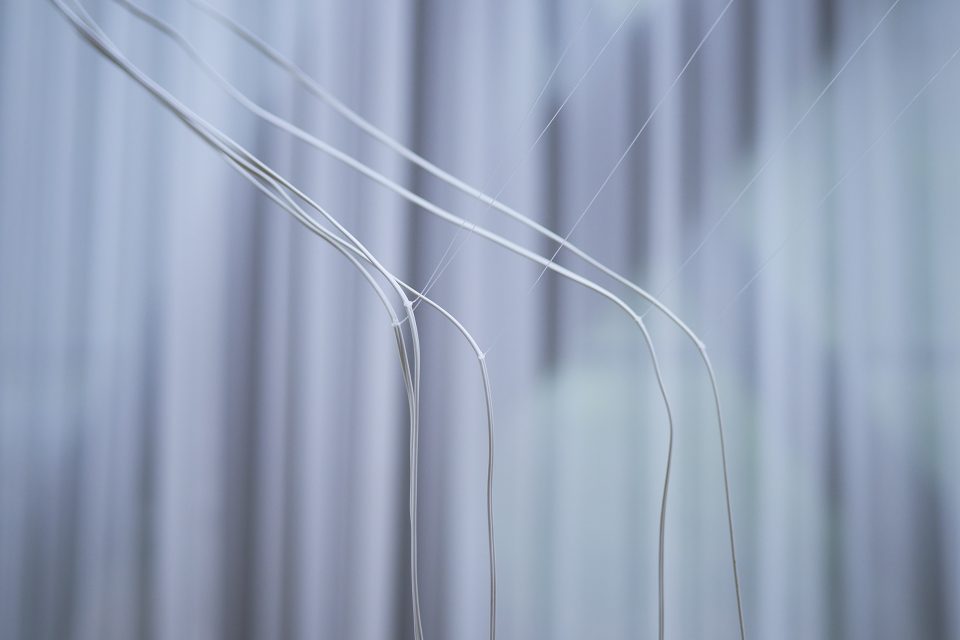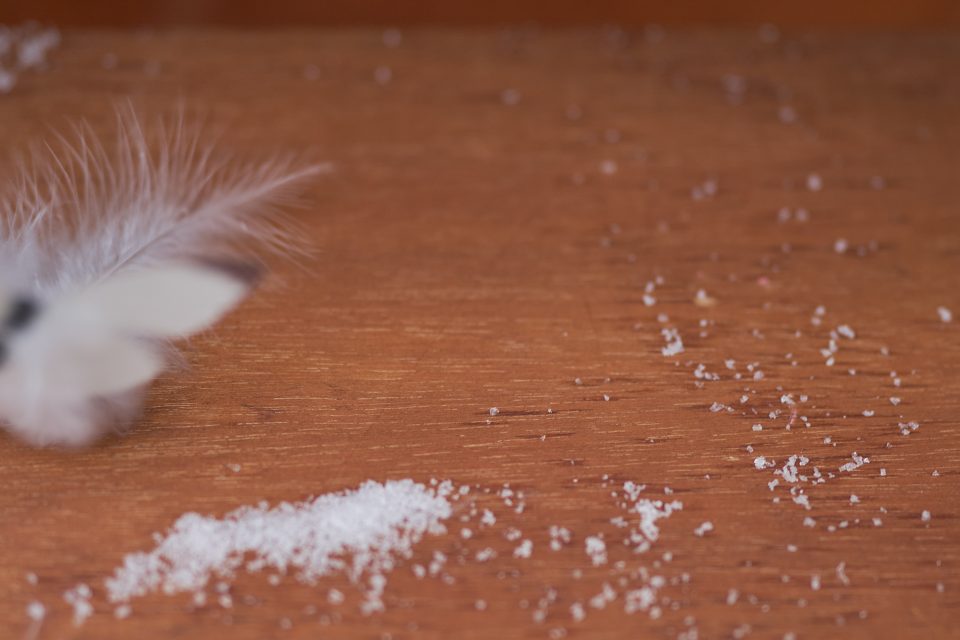 Installation view “Yuko Mohri: I/O” (2011–2023) at The 14th Gwangju Biennale. Courtesy the artist, Project Fulfill Art Space, Taipei, mother’s tankstation limited, Dublin/London and Yutaka Kikutake Gallery, Tokyo. Commissioned by the Gwangju Biennale. Photo: kugeyasuhide
Installation view “Yuko Mohri: I/O” (2011–2023) at The 14th Gwangju Biennale. Courtesy the artist, Project Fulfill Art Space, Taipei, mother’s tankstation limited, Dublin/London and Yutaka Kikutake Gallery, Tokyo. Commissioned by the Gwangju Biennale. Photo: kugeyasuhide
The Japan Foundation (JF) announced on June 12 that artist Yuko Mohri has been selected to exhibit in the Japanese Pavilion at the 60th Venice Biennale, following a series of deliberations by the Foundation’s Advisory Committee on International Art Exhibitions. Korean-born curator Sook-Kyung Lee has been appointed by Mohri to curate her exhibition, making her the first non-Japanese curator in the history of the Japan Pavilion.
The selection jury chairperson Akira Tatehata, who serves as director of the Museum of Modern Art, Saitama, stated in the selection announcement, “Yuko Mohri’s plan involves plugging electrodes directly into decomposing fruit in order to convert changes in the water content of the fruit into electrical values that could be used to generate sounds and lights, creating constantly changing acoustic sculptures. The merging of vegetable life with electrical technology is highly relevant to issues that are of growing concern to us all today.”
He added, “As the artist points out, the process through which fruit emits sweet rotting smells as it steadily reverts to earth represents the cycle of life and death. Moreover, her plan can also be seen as a sharply critical comment on environmental issues. One of the distinctive features of the Japan Pavilion is the opening that passes through the structure from the ceiling to the partly-underground pilotis area. Mohri’s plan is unprecedented in the bold and dynamic use that it makes of that feature.”
Born in 1980 in Kanagawa, Yuko Mohri eschews a composition-based (constructional) approach, creating installations and sculptures centering on phenomena that constantly shift according to various factors such as their environments. She has participated in international group exhibitions, including the Yokohama Triennale 2014 and Sapporo International Art Festival 2014; she undertook a residency in the United States as an Asian Cultural Council (ACC) grantee in the following year. She was named Grand Prix winner of the Nissan Art Award 2015 for her work Moré Moré (Leaky): The Falling Water Given #1-3 (2015) in the same year. In 2018, she staged her first solo museum exhibition “Assume That There Is Friction and Resistance” at the Towada Art Center. She has also participated in numerous international group exhibitions, including the Kochi-Muziris Biennale (2016), the 14th Biennale de Lyon (Musée d’art contemporain de Lyon, 2017), 9th Asia Pacific Triennial of Contemporary Art (Queensland Art Gallery | Gallery of Modern Art, Brisbane, 2018), Glasgow International 2021 (The Pipe Factory, 2021), 34th Bienal de São Paulo (Ciccillo Matarazzo Pavilion, 2021), Asian Art Biennial (National Taiwan Museum of Fine Arts, Taichung, 2021), 23rd Biennale of Sydney (Sydney, 2022), and the 14th Gwangju Biennale (2023).
 Yuko Mohri, Decomposition (2022) Courtesy the artist, Project Fulfill Art Space, Taipei and mother’s tankstation limited, Dublin/London and Yutaka Kikutake Gallery, Tokyo. Photo: kugeyasuhide
Yuko Mohri, Decomposition (2022) Courtesy the artist, Project Fulfill Art Space, Taipei and mother’s tankstation limited, Dublin/London and Yutaka Kikutake Gallery, Tokyo. Photo: kugeyasuhide
In a statement following the announcement, Mohri commented, “Do you remember the protest by two young climate activists who threw canned tomato soup over Vincent Van Gogh’s Sunflowers (1888) at the National Gallery, London in 2022? In an interview with the two Just Stop Oil activists conducted by the editor-in-chief of the art magazine frieze, they pointed out the glaring disparity between the apparent indifference of the general public towards the 33 million Pakistanis affected by the catastrophic floods brought by climate change and the generous attention that mainstream media lavished on the duo’s attack on a work of art. The intention behind staging a protest using art, the activists claimed, was to draw attention to the climate crisis, which the developed world has not acknowledged, let alone taken any action against, despite its devastating effect on so many lives on our planet. The fundamental question posed was, ‘Which is more valuable, art or life?’”
“What I am interested in is how a crisis, paradoxically, sparks the highest levels of creativity in people. This realization served as the fundamental inspiration for this project, triggered by witnessing railway workers in Tokyo ingeniously employing bricolage to stop water leaks at stations. The belief grew stronger within me after observing how the Covid-19 pandemic unfolded, becoming a global catastrophe that transformed everyday life across the world. Venice also experienced a cataclysmic, once-in-fifty-year flood in 2019. Sensing the beginning of a fresh era of response to global challenges, I want to present an innovative vision that opens a new path to the future,” she said.
During the press conference, Mohri also commented that her works and materials including books and CDs, which were stored in a warehouse in the Futaba area of Toride City, Ibaraki Prefecture, were recently damaged by Typhoon Mawar, and the two aforementioned Nissan Art Award Grand Prix-winning artworks had to be disposed of, she explained in a slideshow with supporting images and video footage. She described an anecdote from artist Ryuichi Sakamoto’s posthumous book, in which he recalls how artist John Cage’s experience of losing his luggage provided him an opportunity for a fresh start, which reaffirmed Mohri’s belief that “a crisis, paradoxically, sparks the highest levels of creativity in people.” Commenting on the selection procedure in which the exhibiting artist appoints a curator, Mohri was struck by the theme “soft and weak like water” at the 14th Gwangju Biennale, in which she took part, and explained how she asked artistic director Lee to oversee her exhibition.
 Yuko Mohri, Moré Moré Tokyo (Leaky Tokyo) (2011–2021) Courtesy the artist, Project Fulfill Art Space, Taipei and mother’s tankstation limited, Dublin/London
Yuko Mohri, Moré Moré Tokyo (Leaky Tokyo) (2011–2021) Courtesy the artist, Project Fulfill Art Space, Taipei and mother’s tankstation limited, Dublin/London
Born in 1969 in Seoul, Dr Sook-Kyung Lee is Senior Curator, International, at Tate Modern, London, UK. She has spent most of her almost three-decade career working outside of Korea, where she built up a global network and gained experience organizing large-scale exhibitions. In 2015, she served as Commissioner and Curator for the Korean Pavilion at the 56th Venice Biennale, where she presented an exhibition of the artistic duo Moon Kyungwon and Jeon Joonho. In 2019, she co-curated the international traveling exhibition “Nam June Paik” (2019–2021), which began its run at the Tate Modern. Lee will assume the role of director at the University of Manchester’s Whitworth Art Gallery in August this year.
Following Mohri’s announcement, Lee commented, “I have admired Yuko’s work for some time, finding her choice of everyday, mundane materials and spatial configuration very interesting. Sound and music seem almost integral or embedded to their given spaces, rather than taking a central stage or overly exposed. Yuko’s contribution to the 14th Gwangju Biennale was significant, for her quietly powerful work responded to the theme ‘soft and weak like water’ perfectly. Her work makes us see not just objects but their environment and listen not only intended sound but its ambience and voids. I am confident that Yuko will create a thought-provoking work for the Japan Pavilion in Venice in 2024.”
Lee also expressed her gratitude for the appointment, stating the importance of the Venice Biennale, which brings the contemporary art world together. “Art must confront issues such as planetary emergencies, racial struggles, and colonial legacies,” she said, expressing her hopes for the Japanese Pavilion exhibition, which she and Mohri are creating together.

Installation view “Yuko Mohri: I/O” (2011–2023) at The 14th Gwangju Biennale. Courtesy the artist, Project Fulfill Art Space, Taipei, mother’s tankstation limited, Dublin/London and Yutaka Kikutake Gallery, Tokyo. Commissioned by the Gwangju Biennale. Photo: kugeyasuhide

Installation view “Yuko Mohri: I/O” (2011–2023) at The 14th Gwangju Biennale. Courtesy the artist, Project Fulfill Art Space, Taipei, mother’s tankstation limited, Dublin/London and Yutaka Kikutake Gallery, Tokyo. Commissioned by the Gwangju Biennale. Photo: kugeyasuhide
For this year’s artist selection process, the Japan Foundation commissioned a six-member panel, which shortlisted five artists from a recommendations list selected by a panel of twenty-four Japanese and international jury members. They asked each candidate to confirm possible participation if selected and submit a basic exhibition proposal. Based on the proposals submitted by artists Sachiko Kazama, Tomoko Konoike, Yuko Mohri, and Aya Momose—with the exception of Lieko Shiga, who withdrew as the screening period overlapped with the opening of another exhibition and the artist was unable to consider the exhibition proposal, the committee discussed the proposals with consideration to the artists in the international context, their artistic identity, the impact of the proposed work in the Japan Pavilion exhibition space, and the viability of the proposal. After several rounds of voting, Yuko Mohri was finally selected by majority vote. (See comments regarding the artist selection for the Japan Pavilion)
Japan Pavilion at the 60th International Art Exhibition – La Biennale di Venezia
Artist: Yuko Mohri
Curator: Sook-Kyung Lee (Senior Curator, International Art, Tate Modern, Artistic Director, 14th Gwangju Biennale)
Organizer/Commissioner: The Japan Foundation
60th International Art Exhibition – La Biennale di Venezia
Saturday, April 20 – Sunday, November 24, 2024
http://www.labiennale.org/en
Artistic Director: Adriano Pedrosa (Artistic Director, Museu de Arte de São Paulo)
Five most recent exhibitions at the Japan Pavilion:
59th Venice Biennale (2022)|Dumb Type
58th Venice Biennale (2019)|Motoyuki Shitamichi, Taro Yasuno, Toshiaki Ishikura, Fuminari Nousaku “Cosmo-Eggs”
Curator: Hiroyuki Hattori
57th Venice Biennale (2017)|Takahiro Iwasaki “Turned Upside Down, It’s a Forest”
Curator: Meruro Washida
56th Venice Biennale (2015)Chiharu Shiota “The Key in the Hand”
Curator: Hitoshi Nakano
55th Venice Biennale (2013)|Koki Tanaka “abstract speaking – sharing uncertainty and collective act”
Curator: Mika Kuraya
